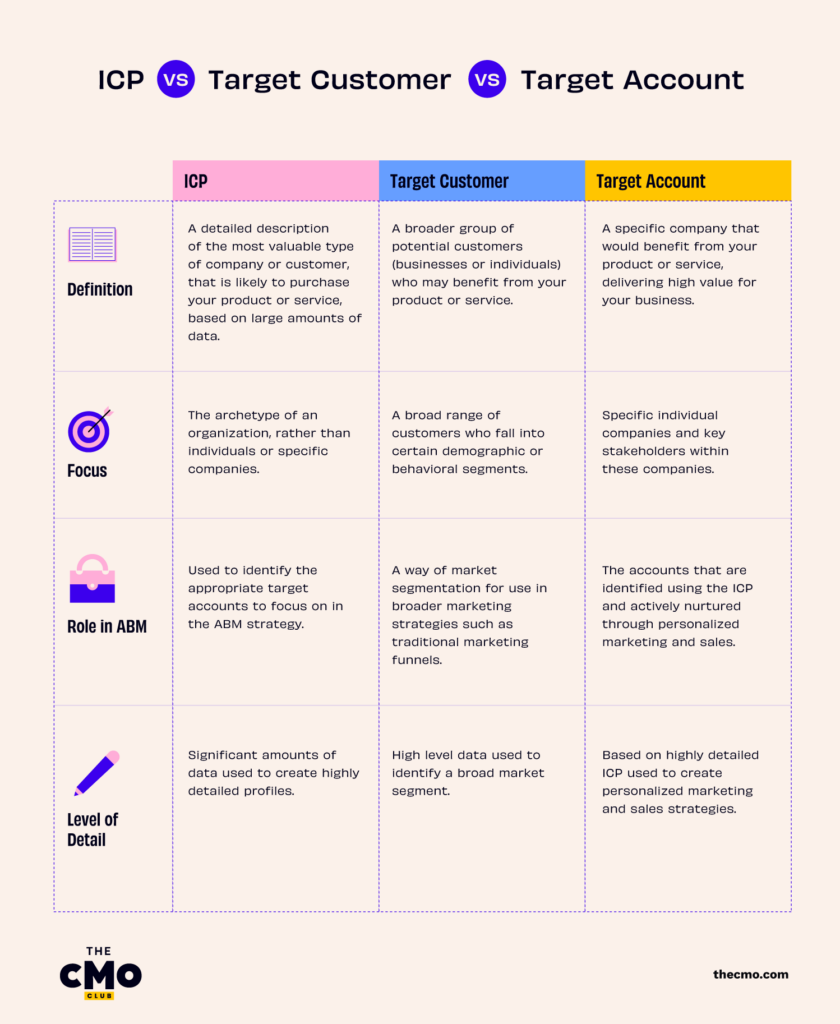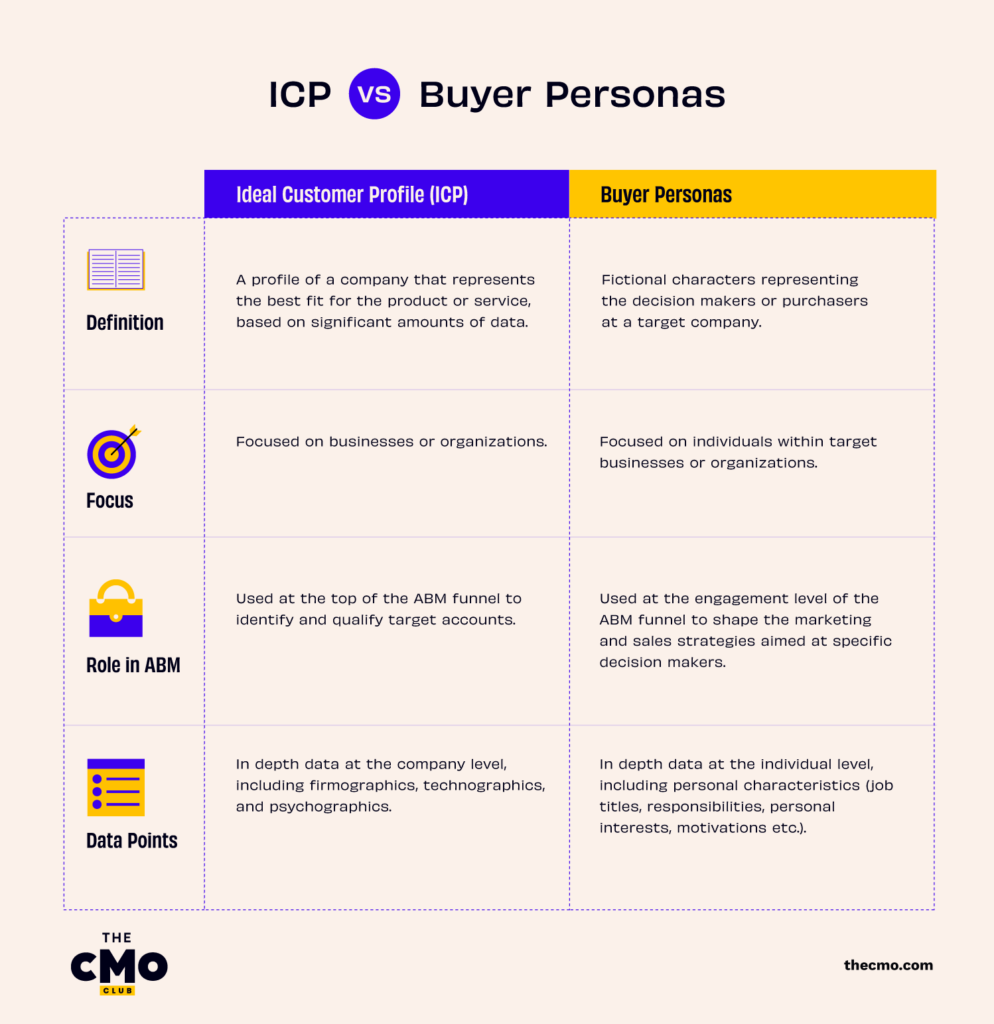Have you ever created a fantastic new product or service that didn’t resonate with customers? Chances are you were missing a clear ideal customer profile. From Google+ to the Facebook Phone, there are many examples of businesses failing to understand their ideal customer when launching new products.
In this article, I'll dive deep into the importance of an ideal customer profile and how you can create your own ICP with our simple 6 step template.
What Is An Ideal Customer Profile (ICP)?
An ideal customer profile (ICP) details the type of customer that would benefit most from your product or service, and be highly lucrative for your business. A comprehensive ICP is incredibly in depth, combining demographic, firmographic, and psychographic data.
This depth of insight is invaluable for marketing campaigns, particularly account-based marketing which relies on selecting and delivering a personalized customer experience to a select number of ideal accounts.
ICP vs Target Customer vs Target Account
An ICP may sound similar to target customers or target accounts, and while there is some crossover, they each fulfill slightly different marketing functions. Let’s consider the differences in more detail:

ICP vs Buyer Personas
Buyer personas are fictionalized potential customers (you might even opt to give them a name) that you use to identify with your potential customers on a personal level and devise personalized marketing strategies.
While there is some crossover, buyer personas are based on an individual while an ICP refers to an entire firm or business. It’s a good idea to use them in conjunction, beginning with your ICP at the top of the ABM funnel and drilling down into buyer personas as you progress down the funnel.

How To Create An Ideal Customer Profile In 6 Steps
1. Make a list of your best customers
Begin by creating a list of your best customers. These are current customers who use your product or service the most and who are most lucrative for your business. To do this, analyze:
- Sales records to identify top value customers
- Customer feedback to identify customers who are highly satisfied
- Product usage stats to identify customers who are regular users
- Customer relationship management history to discount problem customers
2. Collect and analyze customer data
Using existing customer data, begin analyzing your selected best customers to create the characteristics of your ideal customer profile. Don’t forget to involve all customer-facing teams within the company such as sales teams and account managers in order to build a comprehensive profile.
There are three types of data to focus on:
- Firmographics: Specific details about the company including industry, customer base, company size (headcount and/or revenue), pricing, company growth, geographic location, management structure and key decision makers.
- Technographics: If you’re a SaaS or tech business then it will be useful to identify what type of existing technologies are used by your ICP to support different functions like marketing, accounting, sales or product fulfillment. For example, if you sell project management software, understanding how your ideal customer currently tracks projects and priorities will be valuable.
- Psychographics: Understanding the interests and values of your ideal customers can also provide valuable insights. For example, your perfect customer might be particularly tech-savvy or place particular importance on innovation, healthy living or sustainability. Having this information in your ICP will help you to understand their drivers and purchase decision process.
3. Document notable attributes and pain points
Once you’ve covered these core areas, it’s important to consider other important attributes that are specific to your ideal customer. For example, companies operating in a highly regulated industry such as law or healthcare will have certain requirements that will need to be considered, while startups will have very different requirements and budgets compared to market leaders. All of this information is important to include in the ICP.
Once you’ve begun building a clear picture of your ideal customer’s characteristics, it should be easier to identify their individual pain points. Getting the pain points right is essential as it will help shape your marketing and sales messaging. Some common pain points to consider include:
- Operational or technical inefficiencies: Are they experiencing blockages or inefficiencies in their processes, or issues with existing tech?
- Cost: Could you provide a cost effective alternative to a current expense?
- Scaling: Are they facing challenges in their structure or processes which are preventing them from scaling?
- Industry compliance: Are they facing new regulatory burdens or compliance issues, such as the data protection requirements?
- Customer acquisition: Are they experiencing issues with acquiring new customers or expanding into new target markets or demographics?
- Adapting to new business trends: Could you help them adapt to new technology or ways of working. For example, are they struggling with how to incorporate AI into their business or managing data with a remote team?
This is where speaking to your existing customers to understand what drove them to seek out your product and how they use it will be invaluable.
4. Research the unknowns
We are all guilty of jumping to conclusions about our target audience—just think about Colgate Kitchen Entrees. The toothpaste brand’s extension into the ready meal market simply didn’t make sense to consumers. This is why it's so important to identify gaps in your knowledge and research these unknowns.
For example, you may know that your ideal customer is a healthcare company with 100-200 employees looking for a way to train their employees, but do you know which training tools they tried previously and why they didn’t work out?
While your internal CRM system and customer facing teams will provide a good starting point, it’s important to look beyond internal resources to challenge your presumptions and uncover unknowns. Some good ways to do this include:
- Customer surveys and interviews: Conduct customer interviews and surveys to fill in gaps in your knowledge. Just remember to be objective and ask the right questions in order to get the information you need.
- Market research: Look beyond your customer base and carry out market research to understand what you’re missing. You could do this via focus groups or by using a market intelligence firm.
- Social listening: Social media and online forums are another way to research unknowns in the wider market. You could even create a Reddit forum or a Quora forum to gather anonymous feedback.
5. Detail how your company helps your ICP
Now you have a clear picture of your ideal customer, their characteristics and requirements, it’s time to consider how your product or service will solve their pain points. The more detailed you can be, the better. Ask yourself:
- How quickly will your product start to address this pain point?
- Does your product or service require some level of customer education?
- How will your product service continue to support customers as they grow?
These questions will be invaluable in shaping the messaging for your account-based marketing tactics. For example, workplace software tool Slack identified their ICP as tech savvy businesses with remote working teams who struggled with fragmented communication and collaboration, so their marketing is all about how their single communication and collaboration platform can support decision-making, better project management and productivity.
6. Document your findings
Once you’ve gathered all the relevant information, put your findings in a comprehensive document covering all aspects of your ICP characteristics, pain points and how you will address them. It’s important to share and seek feedback on this document from all key stakeholders in your business, especially sales and marketing departments. Remember: it’s a living document which should be kept up to date as markets change and develop.
The final ICP will be used to create your target account list and inform how you interact with these accounts through marketing and sales strategies.
Benefits Of Creating An ICP
An ICP can deliver powerful advantages to your business, including:
Help With Account-Based Marketing (ABM)
According to LinkedIn, 82% of marketers credit ABM with significantly enhancing marketing-sales alignment, but it’s only as effective as the data it’s based on. An ICP provides the framework necessary to accurately identify target accounts and build relationships with them in a rewarding way.
Supporting Personalized Marketing
Companies that use personalization report 40% more revenue according to McKinsey, and an effective ICP is crucial to effective ABM personalization. Through the process of creating your ICP you will build a comprehensive understanding of your ideal customers. This helps you to relate to them in a personal and meaningful way, making your marketing efforts more effective.
Save Time With Lead Scoring
An ICP gives you a set of criteria against which to score and qualify your leads, both marketing qualified leads (MQLs) and sales qualified leads (SQLs). The closer a lead matches your ICP, the higher priority you give it. This enables you to segment quality leads more effectively and dedicate your resources where they will have the most impact.
Speed Up the Sales Cycle
An ICP speeds up every aspect of the sales cycle, from lead generation and qualification through to creating effective marketing and target account selling campaigns. This is particularly valuable when you are selling a complex product or service such as SaaS which can traditionally have long sales cycles.
Increase Customer Lifetime Value (CLV)
An ICP identifies the customers that will get the most out of your product and in so doing become high revenue customers for your business. Not only that, an ICP will support retention and help you identify how you can continue to support your clients as their needs change, whether through upsells, cross sells or new products, leading to longer, more valuable customer relationships.
Improve Your Product-Market Fit
A core step in creating your ICP is identifying your customers’ pain points and how your product or service can solve these issues. With this information you significantly improve your chances of securing product-market fit as well as communicating your offering with personalized marketing and sales campaigns that resonate.
Get Your Ideal Customer Profile Template
Simply enter your email address in the box above to download our handy Ideal Customer Profile Template straight to your inbox.
Join For More Audience Targeting Insights
An ICP is the bedrock of successful and rewarding customer relationships. Without one, it’s almost impossible to create a successful ABM funnel and deliver effective ABM engagement.
Here are my key takeaways for creating a successful ICP:
- Involve all customer-related departments in your ICP. Account management, sales and marketing teams will all have different customer data points to contribute.
- Gather data outside your company too. Market intelligence tools, surveys and even social media will provide valuable information for your ICP that you may be missing.
- Continually update your ICP as your industry develops and your customers’ needs change.
Once you have your ICP, check out the CMO guide to ABM best practices and how to implement a powerful ABM strategy.
While you're here, don’t forget to subscribe to The CMO newsletter to be kept up to date with the latest marketing tactics for SaaS pioneers.


